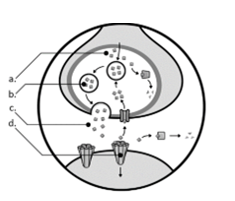Which of the following anatomical structures is directly involved in the production of hormones?
Pituitary ,Pancreas
Penis,Pons
Pancreas ,Penis
Prostate, Pancreas
Correct Answer : A
The pituitary and the pancreas are both structures of the endocrine system that produce hormones involved in body regulation, growth reaand development, sexual functioning, and other processes. The penis Is a structure of the reproductive system that responds to hormones, but it does not produce them. The prostate plays a role in converting testosterone (produced in the testicles) into dihydrotestosterone, but does not actively produce hormones. The pons is located in the brain stem and relays nerve signals that coordinate messages between the brain and the body. The pericardium is a structural component of the cardiovascular system.
TEAS 7 Exam Quiz Bank
HESI A2 Exam Quiz Bank
Find More Questions 📚
Teas 7 Questions: We got the latest updated TEAS 7 questions
100% Money Refund: 100% money back guarantee if you take our full
assessment pass with 80% and fail the actual exam.
Live Tutoring: Fully customized live tutoring lessons.
Guaranteed A Grade: All students who use our services pass with 90%
guarantee.
Related Questions
Correct Answer is B
Explanation
The duodenum is the first section of the small intestine. It receives partially digested food (also called chyme) from the stomach, further digesting it with the help of enzymes released by the gall bladder. Then, the food enters into the jejunum, then the ileum. The large Intestine's main function is the reabsorption of water into the body to form solid waste. It also allows for the absorption of vitamin K produced by microbes living inside the large intestine.
Correct Answer is A
Explanation
In a scientific experiment, the dependent variable is the condition that is being tested and measured. The independent variable is the condition that is being changed or controlled. In this example, the amount of salt is varied, and the boiling point of water is measured. Therefore, the independent variable is the amount of salt, and the dependent variable is the temperature at which the water bolls.
Correct Answer is A
Explanation
Other scientists can validate or disprove the findings.
The purpose of submitting a study for publication in a peer-reviewed journal is to have the study’s methodology, results, and conclusions evaluated by other experts in the field.
This process helps to ensure the quality and validity of the research. Choice B.
Publication in a peer-reviewed journal will guarantee acceptance of the study’s conclusions is incorrect because publication in a peer-reviewed journal does not guarantee acceptance of the study’s conclusions.
The study’s findings may still be subject to debate and further research. Choice C.
Publication in a peer-reviewed journal is unnecessary for this type of study is incorrect because publication in a peer-reviewed journal is an important step in the scientific process for all types of studies.
Choice D.
Publication in a peer-reviewed journal will lead to the manipulation of the study’s results is incorrect because the peer-review process is designed to prevent manipulation of results by ensuring that the study meets rigorous standards for quality and validity.
Correct Answer is D
Explanation
A solid turns into a liquid by melting, and a liquid turns into gas by vaporization.
Correct Answer is D
Explanation
A chemical change involves a chemical reaction and new substances are produced. When baking soda is added to something sour (acidic) it neutralizes the acid and forms new molecules, in this case carbon dioxide and water. A physical change does not produce new substances. Phase changes such as evaporation and sublimation are physical changes. Changing the ratio of ingredients in a mixture, like adding more water to clay, does not change it chemically, but it can change some of the mixture's physical properties.
Correct Answer is C
Explanation
The term "lateral malleolus" refers to the bony prominence on the outer side of the ankle.
It is part of the ankle joint, not the knee joint. The other options, such as the medial collateral ligament, patella, and lateral meniscus, are all associated with the knee joint.
Correct Answer is A
Explanation
Circulation is transporting oxygen and other nutrients to the tissues via the cardiovascular system. ChoiceB refers to blood pressure. Bronchi are the branching airways inside the lungs, while inhalation refers to the process of breathing in.
Correct Answer is D
Explanation
Enzymes are substrate-specific. Most enzymes catalyze only one biochemical reaction. Their active sites are specific for a certain type of substrate and do not bind to other substrates and catalyze other reactions.
Correct Answer is D
Explanation
A hypothesis is the use of prior knowledge in order to provide a hypothetical explanation for why something may or may not occur. A hypothesis can be proved wrong or right based on the results of the experiment and repeated trials.
Correct Answer is B
Explanation
Area B is asynaptic vesicle where the neurotransmitters are stored just before use.

This question was extracted from the actual TEAS Exam. Ace your TEAS exam with the actual TEAS 7 questions, Start your journey with us today
Visit Naxlex, the Most Trusted TEAS TEST Platform With Guaranteed Pass of 90%.
Money back guarantee if you use our service and fail the actual exam. Option of personalised live tutor on your area of weakness.
